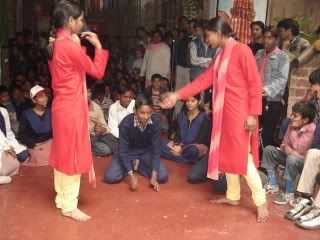In these days of crass commercialization, it is rare to find a commercial entity that pursues its artistic ideals with zeal.
Close to two decades into the publishing industry and Delhi based Katha Publications still pursues the proverb "A picture is better than a thousand words" with full vigor. Set up in 1988, by
Geeta Dharmarajan, Katha, in its eighteen years of existence, has come up with many brilliantly illustrated books and also won many accolades and awards.
Strongly positioned as a publishing house that gives creative freedom and space to its illustrators, Katha has worked with a range of artists, from multiple Award winners to 10 year old first timers. Katha`s Managing Editor Rizio Raj shared with Animation Xpress.com "As a publisher we are very serious about promoting talent. The illustrator should have a versatile style and the quality of his/her work should be good. We encourage variety from page to page so that all pages don`t look alike giving them a portrait look and feel. The layout should be exciting, encourage a variety of illustrations-paint, photography, pastels, computer-generated art, needlecraft, clay and so on. For example, we have worked with award winning illustrators like
Sonali Biswas,
Sudipto Basu,
Vandana Bist and at the same time have also worked with
Ragini Siruguri who is all of 10 years old. Ragini has illustrated her mother Sadhana Ramchander`s "Autorickshaw Blues" for Katha, with special help from Taposhi Ghoshal" added Raj.
At Katha, different illustrators follow different ways of illustrating. For instance, Sonali Biswas who received the Chitra Katha Award 2003 for Outstanding Illustrations for The Lonely Unicorn, a story-counting book published by Katha.
Biswas who has also received the runner-up award from Noma Concours for Children`s Book Illustrations in 2000 first reads the text and then illustrates according to how she interprets it and then lays emphasis on the small details. She adds elements of delight, nudges the imagination of the child, creating an atmosphere where the imagination of the child can go wild.
"Katha gives one the freedom to imagine. It listens to the illustrator and understands that both the illustration and story are complimentary to each other. Also, it doesn`t follow the market but is idealistic. Katha tries to bring out contemporary issues such as health, environment, wildlife and education, where a child not only reads but gets an all round development." shared Sonali.
So what makes the best of illustration talent want to work with Katha?
For Sudipto Basu, a renowned illustrator and the winner of the Katha Chitrakala Award 2002 for The Song of a Scarecrow, a picture book written and illustrated by him, it is the freedom, which one gets at Katha. "Katha focuses on quality and content and gives a lot of freedom to design. An illustrator needs to breathe and Katha gives you that space to do so. Illustrations should look pretty and must be logically connected to the story and should concentrate on the plot as well enhance it."
Katha`s illustrations tell a story themselves be it characters such as Dadoo, the frog or Unicorn or Tiloo puppy, these illustrations are not only beautiful but a story in themselves. One look at them and instantly the child connects with the book.
For Vandana Bist, who has illustrated
Surangini and The Princess with the Longest Hair for Katha, the text is very visual and supports the illustrations. In 1988, she was awarded the encouragement prize in the Children`s Picture Book Competition organised by the Noma Concours Foundation, Japan. Her work has been exhibited in Japan and Bratislava.
MD Rizio Raj concluded, "At Katha we follow certain guidelines when it comes to the quality of the illustrations. We do not encourage static illustrations and believe in work that can give the effect of visual movement and make the characters look alive. Expressions on faces and in posture are absolutely vital and it is also essential that a character appears to be of the same person from page to page, not young, old, tall or short versions. Attention is paid to the description that the text offers where the readers will compare what the author describes with what has been depicted."
Way to go!
 The hot topic of debate was Extreme Science. Under this Memory Game, Spelling Bee, Spin Game, Tongue Twister, Cartoon Contest events were held that were open to all students of the school.
The hot topic of debate was Extreme Science. Under this Memory Game, Spelling Bee, Spin Game, Tongue Twister, Cartoon Contest events were held that were open to all students of the school. 
















